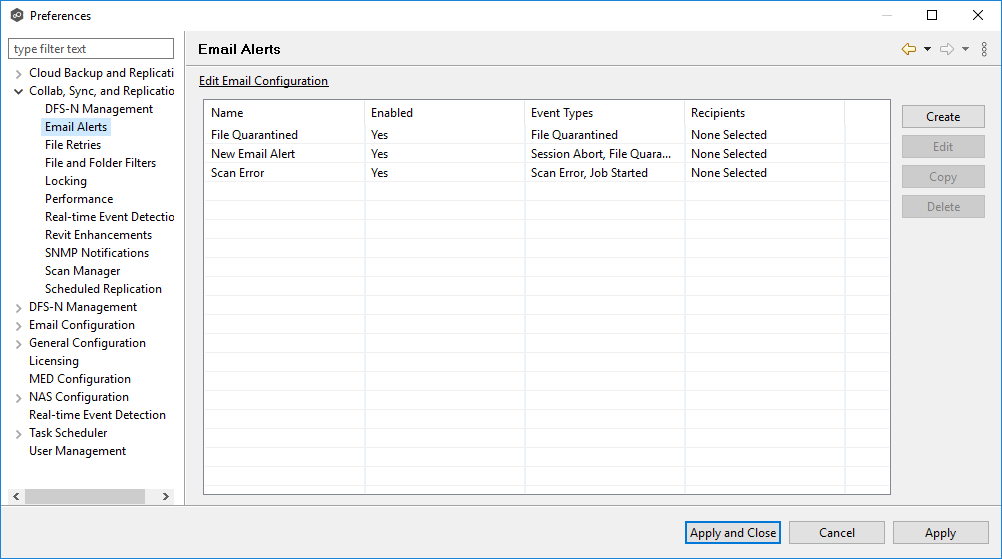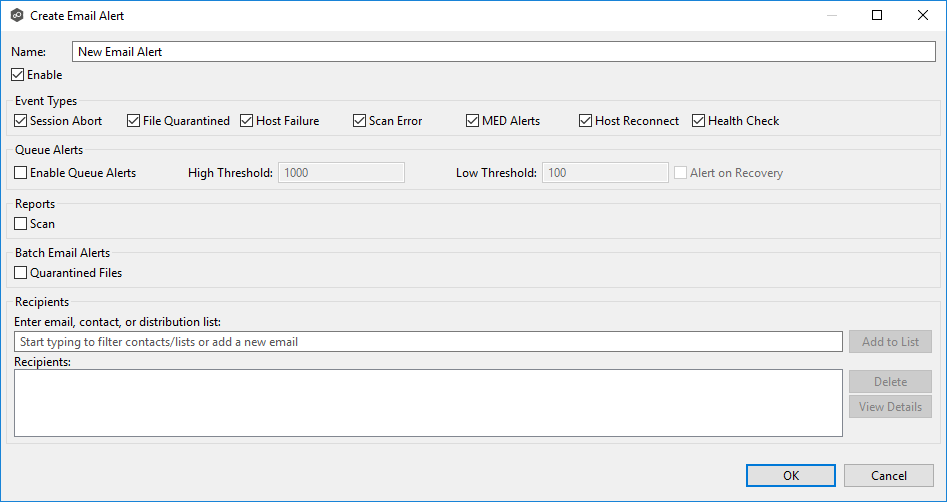When you create a job, you can select existing email alerts to apply to the job or you can create new email alerts and apply them to the job. This Preferences page lists the existing email alerts. From this page, you can view, create, edit, and delete email alerts. However, you cannot edit or delete an email alert while it is applied to a job. See Email Alerts in the Basic Concepts section for more information about email alerts.
Note: An SMTP email connection must be configured before email alerts can be sent. See Email Configuration for information about configuring SMTP email settings.
To create an email alert:
1.Select Preferences from the Window menu.
2.Expand Collab, Sync, and Replication in the navigation tree, and then select Email Alerts.
Any existing email alerts are listed in the Email Alerts table.

3.Click Create.
The Create Email Alert dialog appears.

4.Enter a name for the alert.
5.Select the Enable checkbox if you want to enable the alert.
If you choose not to enable the alert, you can enable it later by editing the alert.
6.Select the event types to be alerted.
The event type determines what will trigger the email alert to be sent.
Event Type |
Description |
|---|---|
Session Abort |
Sends an alert when a session is aborted because of lack of quorum due to one or more failed hosts. |
File Quarantined |
Sends an alert when a file is marked as quarantined because a file conflict was not able to be resolved. |
Host Failure |
Sends an alert when a host timeout occurs, and the host is taken out of session. |
Scan Error |
Sends an alert when an error occurs during the initial synchronization process. |
MED Alerts |
Sends an alert when Peer MED detects potentially malicious activity. For more information, see MED Configuration. |
Host Reconnect |
Sends an alert when the host is reconnected to the job and the job has resumed with the reconnected host. |
Health Check |
Sends an alert when Health Check finds an error. Checks to make sure that real-time information is being communicated. |
7.If you want queue alerts sent, select Enable Queue Alerts and enter threshold values.
Option |
Description |
|---|---|
Enable Queue Alerts |
Sends an email alert when the value in the Queued Items column for that job in the Collab, Sync, and Repl Summary view exceeds the High Threshold value. This column is the combination of the Real-time and File Sync queues as they are displayed in the user interface for the job. This counter is checked every 20 seconds and if it exceeds the High Threshold, an email alert is sent. Another alert will not be sent until the counter has dropped below the Low Threshold value and then exceeds the High Threshold value again. |
High Threshold |
The maximum value for the Queued Items value. When this value is exceeded, an alert is sent. |
Low Threshold |
Once an email has been sent, no additional emails will be sent until the Low Threshold value is met and then the High Threshold value is met again. |
Alert on Recovery |
Controls whether an email will be sent indicating that the counter has recovered to the Low Threshold value after an alert had been previously sent. |
8.Select the Scan checkbox in the Reports section if you want scan statistics emailed to you after a scan has completed.
9.Select the Quarantined Files checkbox in the Batch Email Alerts section if you want email alerts about quarantined files sent to you in batches.
10.Enter alert recipients, and then click Add to List.
The recipients are listed in the Recipients field.
11.Click Apply and Close or Apply.
The new alert is listed in the Email Alerts table and can now be applied to jobs.